How to Generate Sales by Triggering an Emotional Response from Your Customers
Emotions drive our lives.
Whether you recognize it or not, you feel a wide range of emotions on a daily basis. You might even be feeling some emotions right now as you’re reading this.
The word emotion is defined by an instinctive state of mind as a reflection of mood, circumstances, relationships, knowledge, or reasoning.
Sometimes emotions can cause erratic behavior, depending on the circumstances.
Other times, emotions can make people do great things. If someone is feeling inspired, they may create something that changes their life and the lives of people around them for the better.
As a marketer, you need to find ways to put yourself into the minds of the consumer.
You should be developing a customer persona to improve your conversion rates.
Once you can understand how people think, you can use that information to your advantage.
Marketers who know how to leverage the emotions of consumers will have greater success over extended periods of time.
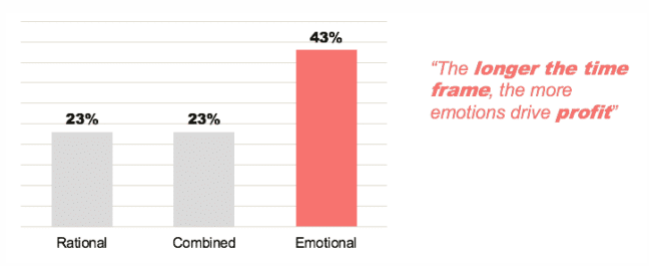
In fact, 43% of emotional advertisements had positive effects on businesses for three or more years.
Ads that trigger stronger than average emotions create a 23% increase in sales volume.
That’s right. If you can elicit an emotional response from your customers with an advertisement, you will increase your sales volume today and potentially for years down the road.
But where do you start? Which emotions work best?
Depending on whom you ask, humans have up to 6, 27, or even 100 emotions.
Honestly, the number doesn’t matter. As long as your strategies can trigger a response that impacts the way the consumer feels, you’re getting the job done.
I’ll show you some of the best ways to generate sales by guiding consumer emotions.
Build trust
Would you give money to someone whom you don’t trust?
I doubt it.
You can assume consumers won’t give money to brands that appear untrustworthy. That’s why you need to take steps to establish trust with your customers.
Take a look at the most trustworthy advertising channels based on a recent survey of consumers:

As you can see, none of the top five responses are forms of digital content.
Online advertising isn’t as trustworthy as other types of advertising channels.
People believe they’ll get scammed online. They are afraid of getting their identities stolen or credit cards compromised.
However, if they know they’re dealing with a trustworthy brand, they’ll feel much safer.
For example, would you hesitate to enter your personal information and credit card number to make a purchase from Apple? Probably not.
That’s because it’s a well-known, established, and credible brand.
But if you’re browsing online and get a popup advertisement from a company you’ve never heard of, will you buy something without asking any questions? I hope not.
If your business doesn’t have a reputation established yet, you need to add credibility to your website.
Showcase customer testimonials. Encourage your customers to review your products.
Display your contact information. Make it easy for people to reach you with any questions, comments, or concerns.
Secure the checkout process. Get rid of ads for other brands on your site. Promote your hassle-free return policy.
If you do things like that, people will trust your business. Once they trust you, they’ll be more willing to buy.
Create FOMO
Fear is a powerful emotion.
I’m not saying you need to scare your customers, although that can be an effective strategy as well.
For example, let’s say your company sells home alarm systems. You could run a video ad showing the results of a robbery.
The camera can show a missing TV that was ripped off the wall, furniture displaced and flipped over, a broken window, drawers pulled out of a dresser. Maybe even show a child’s bedroom turned upside down.
This ad might make people without an alarm system feel afraid that this could happen to them. So they buy an alarm from your company.
However, this type of tactic isn’t reasonable for every business.
Let’s say you sell clothing. It wouldn’t make sense to run an ad scaring people into buying a t-shirt.
Instead, you can create FOMO—the fear of missing out.
Here’s an example of the way Expedia uses this strategy to sell hotel reservations through its platform:
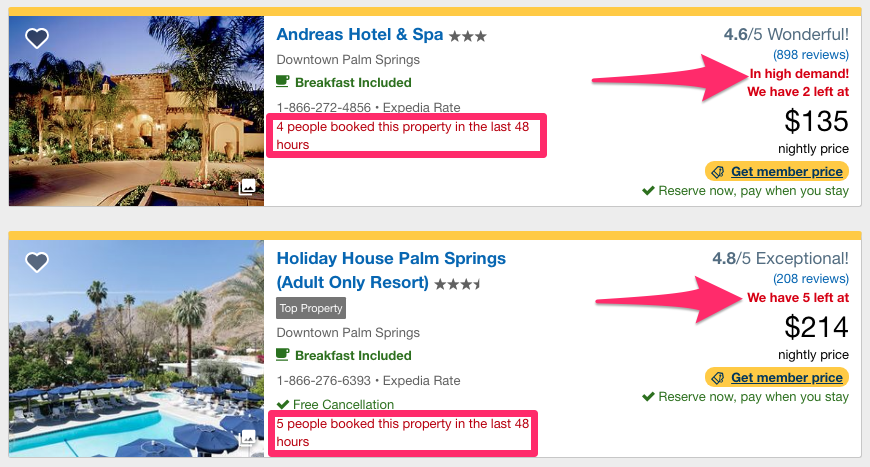
This method is used all over this page.
The first hotel listing states that four other people booked a room at this hotel in the past 48 hours.
Plus, a separate alert states the hotel is in high demand. Only two rooms are left at $135 per night.
As a result, the consumer might feel afraid that if they don’t book the room now, the rate will go up, or the hotel will potentially sell out of rooms.
Expedia doesn’t stop there. When you click on a property to get more details, the FOMO strategy continues:

The platform already told you there are only two rooms left.
But now you find out there are 14 other people viewing this property right now.
This makes the consumer think they need to act even faster to secure the advertised rate.
You can apply the same tactic on your ecommerce website. Put up an alert telling people there is a limited number of a certain product remaining.
I’m not advocating lying to your customers, but nobody will know what you have left in stock. Do what you want with that information.
Identify the desires of your customers
Desire is a strong emotion as well.
Just like you and I, your customers have wants and needs. If you identify what they desire, you can use that to reach them through your marketing campaigns.
Let me show you what I mean.
Here’s an example of a simple advertisement from Calvin Klein:

What do men desire? Women.
Look, I get it. It’s 2018. I’m not here to get into a debate about sexual preferences.
I’m just trying to show you how Calvin Klein’s marketing team positioned this advertisement to stimulate desire.
The ad implies that if you use this cologne, beautiful naked women will be attracted to you.
Obviously, that’s ridiculous. But people will see this ad and react subconsciously with an emotion of desire.
Let me give you another example so you can look at this concept from a different perspective.
Let’s say your company sells running shoes.
What do competitive runners desire? Winning.
You can run an ad showing someone winning a race while wearing your shoes.
Focus on what your customers want. Then tailor your marketing strategy accordingly around that idea to stimulate their desires.
Trigger envy
Envy and jealousy are not considered positive emotions.
However, as a marketer, you can still use them to your advantage. I’m sure you’ve seen ads like this before.
We frequently see commercials on TV advertising products such as fertilizer that will help you grow a lawn that will be greener than your neighbor’s.
Those ads are trying to trigger envy. You walk by your neighbor’s house and see their grass looks better than yours. Time to do something about it.
When you see an ad like that, it speaks to you.
Here’s an example of this strategy used by Zeus Beard:
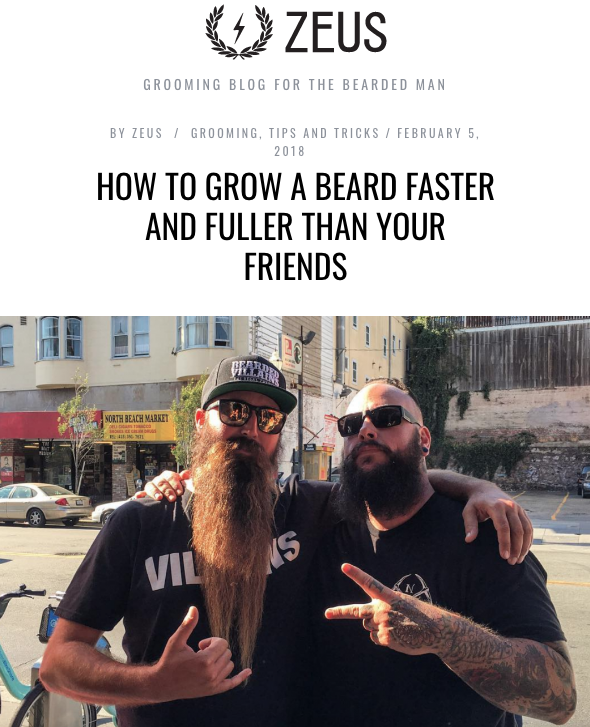
Zeus Beard sells a variety of beard grooming products and accessories.
This blog post explains how people can grow thicker and fuller beards faster than their friends.
Anyone envious of their friends’ or other people’s beards will be inclined to read this content.
After that, they’ll be eager to buy products from this company.
It sounds silly, but it’s human nature to want to be better than others. Whether you want to admit it or not, I’m sure you’re envious sometimes too.
Don’t be ashamed. You’re not alone.
Fortunately, your customers get envious too. Trigger that emotion to get them to purchase from your brand.
Create creative and humorous content
You need to run ads that will get the attention of your current and prospective customers.
Be creative, and try to get some laughs out of people.
Here’s an example from the Old Spice Instagram page:
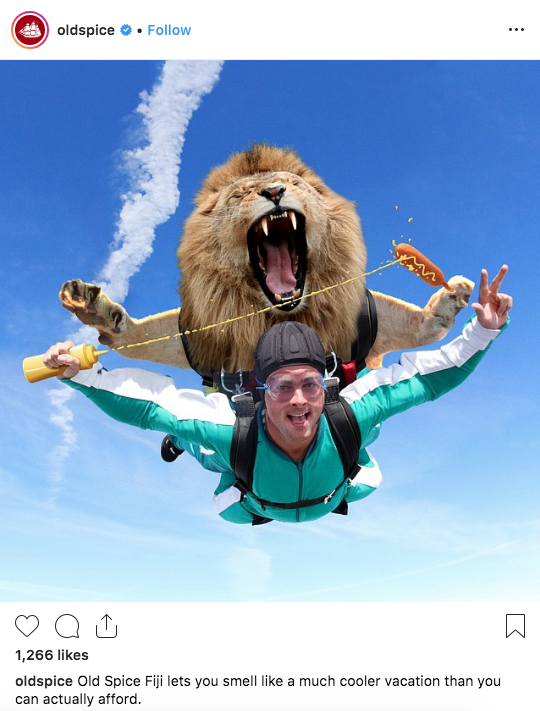
What is happening in this picture?
It looks like this guy is skydiving with a lion on his back while squirting mustard on the corn dog the lion is holding.
Will that make people buy the deodorant? Not necessarily.
But it certainly grabs their attention. It may even make people laugh.
As a result, it will show them the human side of your brand and even establish trust with them—as discussed above.
Laughter will improve the mood of the people viewing your ad.
If someone is happy, they’ll be more likely to buy whatever you’re selling.
Have some fun, and get creative with your next marketing campaign.
Go for a shock factor
Is seeing a skydiving lion shocking? Yes, but that’s not what I’m talking about.
Shock your audience with reality.
Depending on your approach, this strategy can be used to elicit fear, as discussed above.
One of the best ways to shock people is by showing them an alarming statistic to prove the need for whatever you’re selling.
Here’s an example from the Action on Smoking and Health Organization:

This company is trying to get people to stop smoking.
So they ran this ad to inform people how tobacco products can cause diseases leading to death. The idea here is that it’s more common than people think.
Someone may not realize the harm they’re doing to their bodies by consuming certain products.
However, after seeing a shocking ad like this, they may reconsider their actions. As a result, they could reach out to the organization and seek whatever services they’re offering to help them quit the bad habit.
That said, shock doesn’t always have to be associated with fear.
You can shock people with exciting and encouraging news as well.
Inspire your customers
Sometimes, you just need to give people a bit of motivation to accomplish something.
By triggering emotions that inspire consumers, you can encourage them to make a purchase.
Here’s a great example from the Nike website:

Just do it.
We all know this as the Nike slogan. But what does it mean?
This powerful image on the Nike’s website shows what the slogan looks like in real life.
Football is a difficult sport for anyone to play. For someone with only one good arm, it may seem like a crazy dream.
Nike explains that it’s only a crazy dream until you do it, and they have proof to back it up.
Is this content telling people across the globe they can play football with one arm? No.
It’s there to inspire people.
No matter what you think is holding you back, you can accomplish it.
Do you think you’re too overweight to go to the gym? Are you too old to run a marathon?
Whatever you need to overcome, an ad like this can inspire you to do it. Once people feel inspired, they’ll need to buy the right products to help them reach their goals. And that could be your product.
Build anticipation
Anticipation can drive us crazy.
We’ve all been there. Waiting by the phone for a certain call. Sitting in front of the TV anticipating a new episode of your favorite show to start.
Waiting to hear the results of a test.
Once anticipation builds, you can get your customers to buy something.
Here’s an example from the Apple website:

Apple is famous for its keynote events.
During these events, the company announces the launch of new products and software. In the past, some of these announcements have been groundbreaking.
Promoting the event with not much information besides the date, location, and time builds anticipation.
If Apple told people what it was going to announce at the event, it would defeat the purpose.
This is a great example of how to build hype for a new product launch.
Even after new products are announced, they are not available for purchase right away. However, Apple gives its customers the opportunity to pre-order items.
First, the company builds hype by promoting the event. Next, it continues to build anticipation by announcing a new product without launching it.
By the time the product hits the shelves, people are lined up around the corner ready to hand their money over.
Promote kindness
Despite what you might think, people are actually kind.
I know some of you who live in certain places may not agree with that, but just bear with me for a minute here.
If people believe in a certain cause or want to help other people, their kind nature will be brought out.
Take a look at how Box Lunch incorporates this strategy with its overall brand mission:
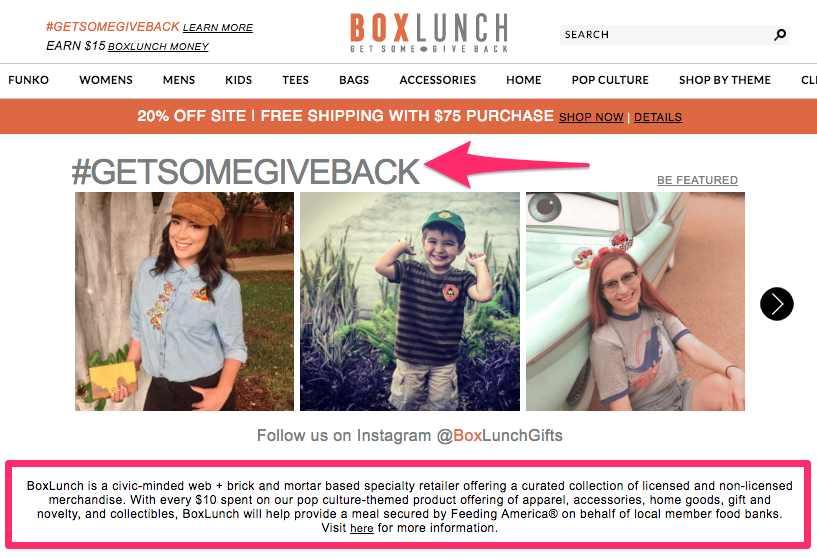
For everyone $10 spent, this company helps provide meals to people in need.
It’s a great pitch to consumers.
Buy from this brand, and you’ll help feed the hungry.
If your company supports charitable organizations, don’t be afraid to share that with your customers. Use that to help elicit an emotional response.
This will help you generate more sales.
Promote joy and happiness
Lots of times people associate certain emotional responses with negative feelings.
Someone may do something stupid if they’re angry. On the flip side, happy and joyful people can be moved to take action as well.
Nobody who is in a bad mood buys coffee for a stranger.
But someone who is having a great day might pay it forward to the car behind them when they’re going through a restaurant drive-thru.
If someone is feeling down or depressed, they probably won’t be as open to spending money.
However, if you can find a way to bring joy to the lives of your customers, they’ll be more likely to buy what you’re selling.
Here’s an example from Tropicfeel:

This startup company sells sneakers for both men and women.
It posted this image on Instagram to show two people having a great time while wearing Tropicfeel sneakers.
Just look at their faces. As a consumer, you almost can’t help but smile seeing how happy these people are.
Sure, they’re models working for this company.
But that doesn’t change the fact that this picture can make you happy.
This relates to my previous point about identifying desires. People have the desire to be happy.
If you can explain through your ads how your brand can make this possible, people will be more likely to convert.
Conclusion
Certain actions and behaviors happen as a result of an emotional response.
Marketers need to recognize this and learn how to turn consumer emotions into sales.
Build trust with your customers. Identify their desires.
Stimulate fear, envy, shock, creativity, and humor.
Be inspiring. Build anticipation. Elicit kindness. Find ways to make your customers feel joyful and happy.
If you can stimulate these emotions properly, consumers will respond by making purchases.
How are you driving sales by leveraging the emotions of your customers?
COntributer : Quick Sprout https://ift.tt/2J3nIHM
 Reviewed by mimisabreena
on
Friday, October 19, 2018
Rating:
Reviewed by mimisabreena
on
Friday, October 19, 2018
Rating:















No comments:
Post a Comment